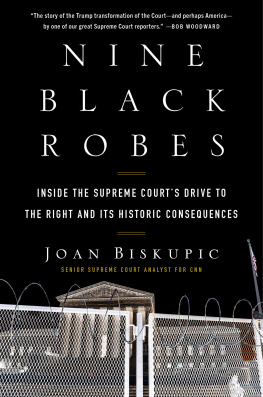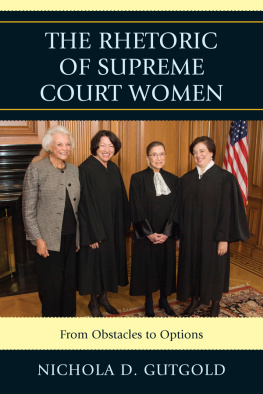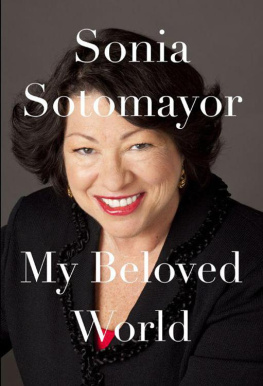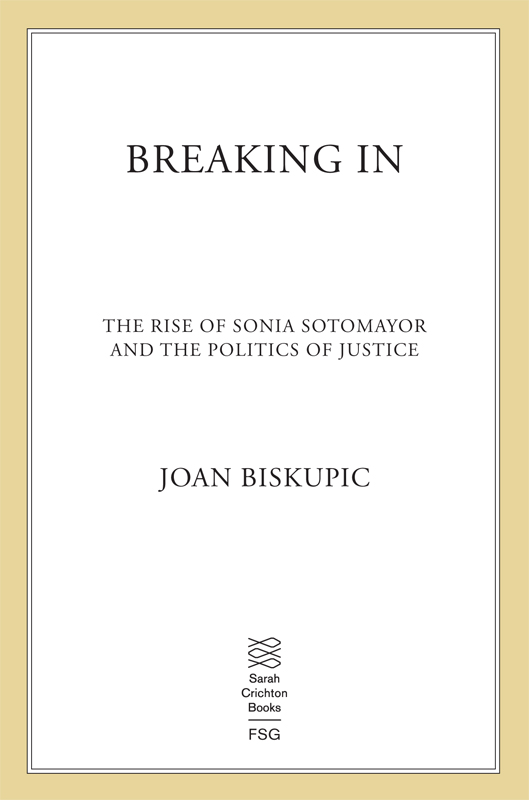Contents
Guide

The author and publisher have provided this e-book to you for your personal use only. You may not make this e-book publicly available in any way. Copyright infringement is against the law. If you believe the copy of this e-book you are reading infringes on the authors copyright, please notify the publisher at: us.macmillanusa.com/piracy.
For Clay and Elizabeth
Contents
I spent countless hours of my childhood looking at the passing subway cars that streaked by my grandmothers windows With some frequency, my cousins and I would make faces at the passing people. Other times, I would stare at the faces at the subway doors and wonder who those people were and what kinds of lives they lived I wonder now if any of those passing subway riders on the Number 5 trains ever saw us in the window of Grandmas apartment. I wonder if they ever wondered who we were and what we would become.
Sonia Sotomayor, in 2007
I stepped into a moment of history.
Sonia Sotomayor, in 2010, one year after her Supreme Court appointment
ONE
Life of the Party
This party celebrating the end of the Supreme Courts annual term is an exclusive affair that bears all the trappings of a staid, cultured institution and its privileged occupants. Festivities are staged in two majestic rooms that face each other across a red-carpeted hallway. Oil portraits of the nations chief justices, all men in dark formal garb, line the oak-paneled walls. Crystal chandeliers hang from the high, gold-glazed ceilings. The large elegant room on the east side of the corridor holds a gleaming grand piano. This is where the entertainment takes place. Across the hall, food and drink are laid out on silver trays and white linencovered tables. As the end-of-term party for June 2010 was approaching, Chief Justice John G. Roberts, Jr., sent invitations to the staff. He mentioned the customary platters of hors doeuvres that would be offered and the law clerks musical parodies that would be presented. He also reminded invitees that the party was open only to full-time Court employees, not to part-time workers, interns, or contractorsanother sign of the special nature of this event at this elite place.
Justice Sonia Sotomayor, a Bronx-born Puerto Rican, was about to attend her first such party. The nations first Hispanic justice had joined the Supreme Court the previous August, a 2009 appointee of the nations first African American president.
Sotomayor had already shown herself to be a different kind of justice. She was more social than the others, kicking up her heels at parties that made the gossip columns. When she danced with actor Esai Morales at a National Hispanic Foundation for the Arts gala, pictures of her in a shiny black jacket and pants went viral; ditto when she donned a New York Yankees jersey and threw out a first pitch for her adored home team. She reveled in the attention.
A few weeks earlier, in June 2010, she had returned to the Bronx as the guest of New York City officials who had renamed the housing project where she grew up. The Bronxdale Houses had become the Justice Sonia Sotomayor Houses. As she stood before three hundred cheering people, Sotomayor recalled how hopeful the Bronxdale Houses had seemed in the late 1950s when she moved there from a run-down tenement. Mayor Michael Bloomberg called her an inspiration to millions of New Yorkers. Later she sang and danced onstage with the choir from her high school. Wearing a bright red jacket, she was loose, at ease, seemingly all confidence.
Now she was back at the Supreme Court for the culmination of her first term and the end-of-term party. After the justices and staff heaped their plates with food, they took seats for the entertainment. Sotomayor sat near the front. So did Justice Ruth Bader Ginsburg, whose husband, Martin, had died three days earlier after a long illness. Ginsburg, a survivor of two serious bouts with cancer, had prided herself on not missing a single day of Court business during her husbands illness. She was exhausted but not about to skip this celebration. Her close friend Justice Antonin Scalia, always an easy target in the law clerks parodies because of his exaggerated mannerisms, secured a spot along a back wall of the room. As the rows of wooden chairs quickly filled, other people began to line the walls, too. About two hundred employees crowded in.
Chief Justice Roberts began the festivities with a Jeopardy -like trivia contest. The three-clerk teams, named Life, Liberty, and the Pursuit of Happiness, fielded his queries as an aide kept score on a whiteboard. Next, the musical spoofs began. Law clerksthe young, mostly Ivy Leaguetrained attorneys who assist the Courtassumed the roles of the nine justices and poked fun at their foibles. The clerks kept these parodies tame. Certain expectations of decorum permeated the Marble Palace, as it has been called. Precedent and consistency were valued in the justices relationships as well as in the law.
Justice Sotomayor was about to upset those expectations. As the skits were ending, she sprang from her chair, turned to the law clerks, and declared that although their musical numbers were all fine enough, they lacked a certain something. With that, a law clerk cued salsa music on a small portable player, and Sotomayor began dancing. She took quick steps forward, then back, and turned, then went forward, back again. The Cuban- and Puerto Ricaninspired rhythms were as new to this setting as the justice who was dancing. For her salsa partners, Sotomayor first grabbed a few law clerks, who, it became clear, had arranged this diversion with her. Then she beckoned the justices, starting with Chief Justice Roberts. A buttoned-down man who rarely shed his suit jacket at the Court, Roberts was reluctant, looking terribly uncomfortable. The audience was apprehensive. By tradition, this was an event where the law clerks performed and the justices watched. Roberts decided to be a good sport. He got up and danced with her. Briefly.
Sotomayors barrel-ahead style clashed with the usual order and predictability at the Supreme Court. The institution operates on a down-to-the-minute schedule. Everyone knows his or her place, which corridors are open, which are closed. Steady, quiet rhythms control, for better or worse, reflecting the ideal of consistency in the law. But now a justice was dancing salsa in a room where portraits of former chief justices set the stodgy tone. Sotomayors hips swayed to the beat of the distinctive drums and horns, and as her thick, curly black hair fell into her face, she brushed it away with her hand.
As she sought out partners, nervous colleagues danced a bit, one by one, then retreated to their chairs. Justice Anthony Kennedy, six foot two and favoring dark suits with coordinated tie and pocket handkerchief, did a jitterbug-style move. Justice John Paul Stevens, at age ninety the eldest, got up, too, but he felt as if he had two left feet and quickly sat down, happy to watch Sotomayor move on to other partners.
Wheres Nino? she shouted toward the back. Scalia, his thinning black hair slicked back, started to shake his head. There was no way he was going to dance. But then he did, sort of. Justice Samuel Alito, tall and shy, looked even more awkward when Sotomayor got to him. He resisted. But the rest of the audience was into the spectacle now. People were standing up, laughing and whooping. So Alito stood and danced a little bit. Then Sotomayor went toward Ginsburg, who had just endured some of the most difficult days of her life. She did not want to rise from her chair, but Sotomayor whispered to her that her late husband would have wanted her to dance. Ginsburg relented and followed Sotomayor in a few steps. Ginsburg put her hands up to Sotomayors face. Holding her two cheeks in her palms, Ginsburg said, Thank you.








